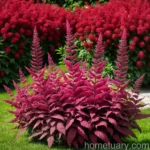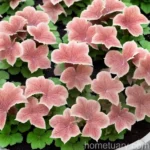Plant Scientist’s Guide to Foamy Bells (Heucherella ‘Alabama Sunrise’)
Introduction
As a plant scientist, I am thrilled to delve into the world of Heucherella ‘Alabama Sunrise,’ also known as foamy bells. This exquisite perennial, a hybrid between Tiarella and Heuchera, has garnered attention for its attractive foliage and adaptability to various growing conditions. In this comprehensive guide, we will explore the nuances of caring for this charismatic plant, its diverse uses, and its role in enhancing gardens and landscapes. Join me in unraveling the secrets of Heucherella ‘Alabama Sunrise’ and discover how to cultivate this delightful plant to perfection.
What is Plant: Foamy Bells (Heucherella ‘Alabama Sunrise’)
Heucherella ‘Alabama Sunrise’ is a striking perennial that belongs to the Saxifragaceae family. This hybrid cultivar is a result of crossing Heuchera and Tiarella, thus combining the best traits of both genera. The resulting plant displays magnificent foliage and petite, delicate flowers, making it a sought-after addition to gardens and landscapes.
Key Takeaways – Foamy Bells (Heucherella ‘Alabama Sunrise’)
Before delving into the intricacies of caring for Heucherella ‘Alabama Sunrise,’ let’s take a closer look at the key takeaways, including its culture, uses, and essential care requirements.
Culture
- Heucherella ‘Alabama Sunrise’ is a hardy perennial that thrives in various climatic conditions.
- It exhibits exceptional adaptability and can be grown in containers, borders, and woodland gardens.
- This plant is valued for its low maintenance nature, making it an ideal choice for both novice and experienced gardeners.
Uses
- Heucherella ‘Alabama Sunrise’ serves as a remarkable ground cover, adding splashes of vibrant colors to the landscape.
- It is a popular choice for edging, mass planting, and integrating into mixed perennial borders.
- The foliage and flowers of Heucherella ‘Alabama Sunrise’ contribute to stunning container displays, accentuating patios and outdoor living spaces.
Now that we have a glimpse of the plant’s culture and uses, let’s delve into its care requirements, encompassing water, sunlight, fertilizer, soil, pruning, propagation, and its suitability for containers.
Water
Proper watering is essential for ensuring the optimal growth and health of Heucherella ‘Alabama Sunrise.’ This plant thrives in moist, well-draining soil and is sensitive to waterlogged conditions.
- Watering Frequency: During the active growing season, consistent moisture is crucial. Water the plants regularly, ensuring that the soil remains evenly moist but not waterlogged.
- Drought Tolerance: Despite its preference for adequate moisture, Heucherella ‘Alabama Sunrise’ exhibits moderate drought tolerance once established. However, prolonged periods of drought may lead to stress and reduced vigor.
Sunlight
The sunlight requirements of Heucherella ‘Alabama Sunrise’ contribute significantly to its overall performance and appearance. Understanding its preferences for light exposure is pivotal for cultivating this plant successfully.
- Optimal Sunlight: Partial to full shade is ideal for Heucherella ‘Alabama Sunrise.’ Position it in locations where it receives dappled sunlight or partial shade throughout the day. Avoid exposing it to intense, direct sunlight, especially during the peak hours of the afternoon.
- Sun Tolerance: While it thrives in shaded conditions, it can withstand some morning sun or filtered sunlight. However, prolonged exposure to intense sunlight may result in leaf scorching and diminished vigor.
Fertilizer
Supplemental fertilization can significantly enhance the growth and ornamental appeal of Heucherella ‘Alabama Sunrise.’ Employing appropriate fertilization practices ensures that the plant receives essential nutrients for robust growth and vibrant foliage.
- Fertilizer Type: Apply a balanced, slow-release fertilizer in spring, as the plants resume active growth. Opt for a formulation with equal proportions of nitrogen, phosphorus, and potassium, or select a fertilizer specially formulated for flowering perennials.
- Application Frequency: A single application in spring is generally adequate. If the plants exhibit signs of nutrient deficiencies or lackluster growth, a second application in midsummer can be beneficial.
Soil
The soil composition greatly influences the overall health and vigor of Heucherella ‘Alabama Sunrise.’ Understanding its soil preferences is imperative for creating an optimal growing environment.
- Well-Draining Soil: Heucherella ‘Alabama Sunrise’ thrives in well-draining, humus-rich soil. Ample organic matter facilitates moisture retention while preventing waterlogging.
- Soil pH: It prefers slightly acidic to neutral soil with a pH range between 5.8 and 6.5. Conduct a soil test to determine the pH of the planting site and make necessary amendments to achieve the preferred pH range.
Pruning
Pruning plays a crucial role in maintaining the aesthetic appeal and vigor of Heucherella ‘Alabama Sunrise.’ Regular pruning encourages new growth, prevents overcrowding, and revitalizes the plant’s appearance.
- Foliage Removal: Remove any withered or discolored foliage throughout the growing season to uphold the plant’s visual appeal.
- Spring Cleanup: In early spring, conduct a thorough cleanup to eliminate any debris, dead foliage, and overwintered leaves. This rejuvenates the plant and promotes vigorous growth as the new foliage emerges.
Propagation
Propagating Heucherella ‘Alabama Sunrise’ enables gardeners to expand their collection and propagate plants with desirable traits. Several propagation methods can be employed to propagate this hybrid perennial.
- Division: Division is a reliable method for propagating Heucherella ‘Alabama Sunrise.’ During the early spring or fall, carefully divide mature clumps, ensuring that each division possesses a viable portion of roots and foliage.
- Stem Cuttings: Propagate new plants from stem cuttings taken from the parent plant. Select healthy, non-flowering stems and root them in a well-draining medium to establish new plants.
Container Popularity
Heucherella ‘Alabama Sunrise’ has gained significant popularity as a container plant, offering an array of compelling advantages for container gardening enthusiasts.
- Versatile Displays: Its vibrant foliage and compact growth make it an ideal candidate for embellishing container gardens, patios, and balconies.
- Seasonal Accents: Utilize Heucherella ‘Alabama Sunrise’ to craft seasonal container displays, incorporating complementary plants to create stunning combinations throughout the year.
Common Diseases
While Heucherella ‘Alabama Sunrise’ is generally resilient to diseases, several common fungal and bacterial issues can affect its health and vigor if left unaddressed.
- Leaf Spot: Fungal leaf spot diseases can afflict the foliage, resulting in unsightly lesions and diminished aesthetic appeal.
- Powdery Mildew: Prolonged high humidity or inadequate airflow can lead to powdery mildew, manifesting as powdery white patches on the foliage.
Disease Diagnosis
Diagnosing and addressing potential diseases promptly is crucial for safeguarding the health of Heucherella ‘Alabama Sunrise.’
- Visual Inspection: Regularly inspect the foliage for any signs of discoloration, lesions, or abnormal growth patterns.
- Consultation: If symptoms of disease become apparent, seek guidance from local plant disease specialists or extension offices for accurate diagnosis and treatment recommendations.
Common Pests
Heucherella ‘Alabama Sunrise’ is relatively resistant to pest infestations, but several common pests can still pose a threat to its vitality.
- Snails and Slugs: These voracious pests can feed on the tender foliage, resulting in unsightly damage and diminished plant vigor.
- Root Weevils: These pests can undermine the plant’s health by feeding on the roots, leading to stunted growth and wilting.
Botanist’s Tips
For achieving optimal success in cultivating Heucherella ‘Alabama Sunrise,’ consider the following expert recommendations and tips.
- Mulching: Apply a layer of organic mulch around the plants to conserve soil moisture, inhibit weed growth, and enhance the aesthetic appeal of the planting area.
- Air Circulation: Ensure that the planting site provides adequate air circulation to reduce the likelihood of fungal diseases and pest infestations.
Fun Facts
Uncover some fascinating tidbits about Heucherella ‘Alabama Sunrise’ that highlight its unique characteristics and allure.
- Hybrid Origins: Heucherella ‘Alabama Sunrise’ is a hybrid between Heuchera and Tiarella, combining the best traits of both genera.
- Foliage Variations: The foliage of Heucherella ‘Alabama Sunrise’ exhibits captivating color variations, transitioning through seasonal shifts and environmental influences.
Links to External Resources
Expand your knowledge of Heucherella ‘Alabama Sunrise’ and acquire valuable insights by exploring the resources linked below:
- The American Heuchera Society
- Royal Horticultural Society – Heucherella ‘Alabama Sunrise’ Profile
- The Gardening Channel – Growing Heucherella
- Perennials.com – Heucherella ‘Alabama Sunrise’ Overview
Conclusion
As we conclude our exploration of Heucherella ‘Alabama Sunrise,’ I hope that this in-depth guide has equipped you with comprehensive knowledge of this captivating perennial. From its culture and uses to essential care requirements and propagation techniques, Heucherella ‘Alabama Sunrise’ exhibits remarkable versatility and ornamental appeal. Whether employed as a ground cover, container specimen, or textured border accent, this hybrid perennial elevates gardens with its vibrant presence and enduring charm. Embrace the allure of Heucherella ‘Alabama Sunrise’ and craft enchanting landscapes imbued with its captivating foliage and delicate flowers. Happy gardening!
















